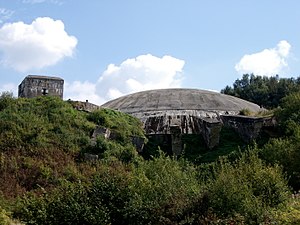Our website is made possible by displaying online advertisements to our visitors.
Please consider supporting us by disabling your ad blocker.
Operation Crossbow
| World War II Operation Crossbow | |||||||
|---|---|---|---|---|---|---|---|
| Part of Strategic bombing campaigns in Europe | |||||||
 The La Coupole V-2 launch site at Wizernes in France was destroyed by bombing before it could be brought into use | |||||||
| |||||||
| Belligerents | |||||||
|
|
| ||||||
| Strength | |||||||
|
Sorties/bomb tonnage: |
V-1 launches: 9,251[7]
(8000 targeting London,[8] 2,448 targetting Antwerp)[9] 1402 76 19 11 | ||||||
| Casualties and losses | |||||||
|
Airmen/aircraft:
British civilians killed/seriously injured:
|
V-1: 4,261 destroyed by AA guns (1,878) 48/69 rockets/vehicles damaged[13] | ||||||
Crossbow was the code name in World War II for Anglo-American operations against the German long range reprisal weapons (V-weapons) programme. The primary V-weapons were the V-1 flying bomb and V-2 rocket, which were launched against Britain from 1944 to 1945 and used against continental European targets as well.[3]
Initial intelligence investigations in 1943 into the progress of German long range weapons were carried out under the code name Bodyline. On 15 November, a larger operation was set up under the name Crossbow.[14] Post-war, Crossbow operations became known as "Operation Crossbow" particularly following the 1965 film of the same name.
Crossbow included strategic operations against research and development of the weapons, their manufacture, transportation and attacks on their launch site, and fighter intercepts against missiles in flight.[2]: 7 At one point, the British government, in near panic, demanded that upwards of 40% of bomber sorties be targeted against the launch sites.[citation needed]
The Crossbow attacks were not very successful, and every raid carried out against a V-1 or V-2 launch site was one fewer raid against other targets in the Third Reich. The diversion of Allied resources from other targets represented a major success for Hitler.[3][15]
- ^ Collier 1976, p. 136.
- ^ a b D'Olier, Franklin (30 September 1945), "The Secondary Campaigns", United States Strategic Bombing Survey, Summary Report (European War), p. 12, retrieved 23 March 2020 – via Hyperwar Foundation
- ^ a b c Cite error: The named reference
Metswas invoked but never defined (see the help page). - ^ Cite error: The named reference
Cravenwas invoked but never defined (see the help page). - ^ Krause, Merric E (June 1988). From theater missile defense to anti-missile offensive actions: A near-term strategic approach for the USAF (PDF) (Thesis). School of Advanced Airpower Studies, Air University. p. 11. Archived from the original (PDF) on 29 October 2008. Retrieved 23 October 2008.
- ^ Cite error: The named reference
AllWorldWarswas invoked but never defined (see the help page). - ^ a b Charman, Terry, The V Weapons Campaign Against Britain 1944–1945 (PDF), Imperial War Museum, archived from the original (PDF) on 19 March 2014, retrieved 9 April 2013
- ^ von Braun, Wernher (Estate of); Ordway, Frederick I. III & Dooling, David Jr. (1985) [1975]. Space Travel: A History (1st ed.). New York: Harper & Row. p. 105. ISBN 0-06-181898-4.
- ^ Cooksley 1979, p. 82.
- ^ Russell, Edward T (1999), Leaping the Atlantic Wall: Army Air Forces Campaigns in Western Europe, 1942–1945 (PDF), The U.S. Army Air Forces in World War II, United States Air Force History and Museums Program, p. 27, archived from the original (PDF) on 27 June 2004, retrieved 19 March 2014
- ^ Zaloga 2018, p. 92.
- ^ Cite error: The named reference
Hillsonwas invoked but never defined (see the help page). - ^ Collier 1976, p. 135.
- ^ Gruen 1998, p. 4.
- ^ Craven and Cate, p540 said the "campaign of the summer of 1944 must be regarded generally as having failed to achieve its objectives...In general, then, the large-scale CROSSBOW operations during the critical period were a failure" but "offered firm evidence that the Allies could respond too generously rather than too niggardly to whatever threats might arise."
Cite error: There are <ref group=lower-alpha> tags or {{efn}} templates on this page, but the references will not show without a {{reflist|group=lower-alpha}} template or {{notelist}} template (see the help page).
Previous Page Next Page


